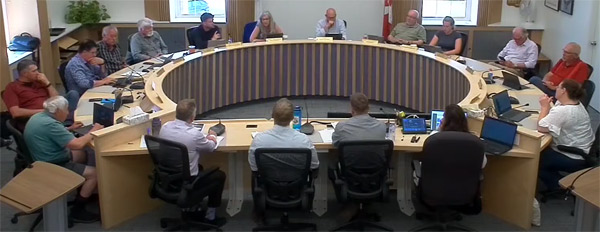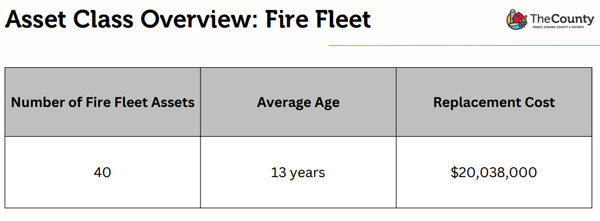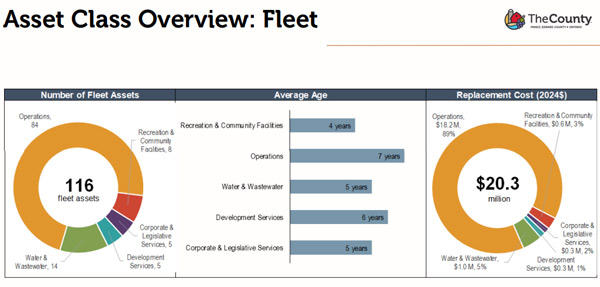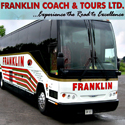Fire equipment concerns among vehicle, and recreation asset discussions
Administrator | Jun 14, 2025 | Comments 3

By Sharon Harrison
In the final of a series of three informal, but in-depth working sessions with council and County staff, corporate vehicles, the fire fleet, and parks and recreation assets were discussed.
Details on the three asset classes discussed in this week’s working session focused on the fire fleet (vehicles), corporate fleet (vehicles), and parks and recreation assets, the basic outlines of which are listed below.
 FIRE FLEET (VEHICLES)
FIRE FLEET (VEHICLES)
Of the municipality’s 156 fleet assets, 40 are fire fleet vehicles (fire service vehicles) supporting fire protection services, and it maintains eight accredited stations Vehicles include first-line duty apparatus (pumpers), second-line units (pumpers), tanker trucks, a trailer, support vehicles and rescue boats.
Prince Edward County’s fire fleet is a critical component of the municipality’s emergency response operations ensuring safe emergency services for the entire County.
The average useful life of the fire fleet is 20.5 years; the average age of the fire fleet currently is 13 years. The total replacement cost is $20 million.
Fire Chief Chad Brown spoke extensively on the subject, noting how Prince Edward County’s fire and rescue service “is facing a critical challenge: an aging fire apparatus fleet that is increasingly hindering the department’s ability to deliver the prescribed level of service“.
Levels of service
Two levels of service options were presented to council in the fire fleet asset category, each with a different cost implication:
Option 1 – Maintain the annual lifecycle of the fire fleet. Achieving this LoS for the next 10 years (2025-2035) would require an estimated annual investment of $1 million;
OR
Option 2 – Limit services for certain fire fleet assets. To determine how much this will cost the municipality, council will have the opportunity to go to through each specific reduction at the final asset management meeting (on August 28).
It is noted in the discussion paper that over the past three budget cycles, the municipality invested in its fire fleet during the 2023 ($820,000) and 2024 ($665,000) budgets, with no investment allocated for the three-year period from 2025 to 2027. It was further noted that the County tax base funds the entire fire department.
“When council sets the levels of fire protection services, it also takes on the responsibility of funding them. This can make it challenging to keep up with evolving equipment standards, hire more staff, or invest in important training programs while still maintaining the approved level of service within the annual operating and capital budgets.”
To maintain what we have is clearly not going to be an option, said Brown. “So what does the future look like, and how do we get to a future point where we can all agree is an appropriate level of service based on what we need to do for our community, and what does that service look like if it’s not what it is today”.
“It’s complicated,” said Ferguson, “The level of service has to align with the availability of equipment to provide that service, and is that something that we piece out all over the municipality or centralize it, and then there is response time and everything else that comes.
And there is regulation, provincial and otherwise, which further complicates.”
Councillor Roy Pennell asked about the possibility of buying used fire vehicles, asking why the municipality isn’t prepared to look at that. “It’s almost like we are creating an empire in that everything’s got to be new,” said Pennell.
Brown said they can’t buy older apparatus.
“Frankly, we have a bunch of older apparatus. What it means is what does council wish to authorize for the level of service? If you want old apparatus, we can have old apparatus, but we can’t be doing high-risk operations with old apparatus. Council, at that point, would seriously really need to look at a legal opinion to look at what the risks and liabilities are,” Brown emphasised.
Nieman once again asked if vehicles need to be replaced at 20 years.
“I am having a hard time saying yes, that we need to replace it at 20 years,” said Nieman. “We have to have at least one truck that is class one, whether it’s a pumper or the ladder truck, and I don’t think the ladder truck should be the first vehicle to go to a call, especially of you don’t need a ladder truck, but I’m no fireman.”
“We are beating the heck out of the most expensive fleet vehicle we have because we don’t have another in-date serviced truck currently available to cover the two areas that have a delayed level of service,” Brown confirmed.
He said, the only 20-year in-date truck they have to respond to offer the current level of service that is authorized, is the aerial truck. He noted a new pumper is expected hopefully in July.
The current approved service level differentials restrict firefighters from performing immediate life-saving operations in many areas of the County.
For example, the discussion paper notes in regions such as Ameliasburgh and Cressy, local firefighters are limited to a single pumper and a small responding crew. Demorestville and Milford do not have first-duty apparatus due to the decision not to replace the aging pumpers.
“The lack of first-duty apparatus in these areas means residents and firefighters must await a first-duty apparatus specifically approved for high-risk operations. Delays in first-duty apparatus arrival mean firefighters are not authorized or equipped to enter burning structures for rescues or perform interior fire suppression.”
“Despite these constraints, some firefighters may feel compelled to take unauthorized actions, putting themselves and the corporation at serious health and safety risk,” explained Brown. ”At the same time, when they follow protocol and cannot act immediately, the department faces intense criticism from both the media and citizens, who may not understand or accept the service levels in place.”
Brown said council may reduce the level of fire protection services at any time. Reductions may include eliminating certain services, reducing a service from an operations level to an awareness level, or consolidating a service by limiting it from a primary location and increasing the response time.
“The decision is never easy, as the impacts on the public may be dramatic. However, it is recommended that the council seek a legal opinion before making any changes to better understand the risk profile created by the service level change. “
He said, all changes to service levels also require official notification to the residents to ensure awareness when requesting services.
“Council should note that a delay in service has already been authorized in areas around the County, as pumps 3, 4, 9 and 10 are not to be used for high-risk operations. These areas require a response from stations located further away and can delay response times and place firefighters and the public at greater risk during urgent rescue operations.”
 CORPORATE FLEET (VEHICLES)
CORPORATE FLEET (VEHICLES)
The municipality owns and maintains a total of 156 fleet assets, comprising 116 corporate fleet vehicles supporting a wide range of municipal operations. The fleet is categorized into light-duty vehicles, heavy-duty vehicles, and specialized equipment, and includes SUVs, light trucks and vans, along with heavy-duty trucks, backhoes, graders, and specialized equipment (skid steers and sidewalk plows).
The 116 fleet assets are allocated as follows:
Corporate and legislative services department: Five fleet assets (average age: five years)
Development services department: Five fleet assets (average age: five years)
Water and wastewater department: 14 fleet assets (average age: five years)
Operational services department: 84 fleet assets (average age: eight years)
Recreation and community facilities department: Eight fleet assets (average age: four years).
The combined replacement cost is $20.3 million, made up of $0.3 million (corporate and legislative services), $0.3 million (development services), $1 million (water and wastewater), $18.2 million (operational services), and $0.6 million (recreation and community facilities).
The average conditions of fleet assets ranges from good to very good.
“However, there are 20 fleet assets with a combined replacement cost of approximately $7.4 million (representing approximately 19 percent of the total replacement cost) that have been rated as poor or very poor because they are in use beyond their typical useful life.”
Levels of service
Two levels of service options were presented to council in the corporate fleet asset category, each with a different cost implication:
Option 1 – Maintain fleet assets within useful life or at good or acceptable condition. Achieving this LoS for the next 10 years (2025-2035) would require an estimated annual investment of $1.5 million;
OR
Option 2 – Extend corporate fleet asset lifecycles by 25 percent. Achieving this LoS for the next 10 years (2025-2035) would require an estimated annual investment of $1.2 million.
“Council will ultimately select a preferred level of service for the fleet with associated annual costs and implications for quality, safety and financial sustainability. The selected level of service will serve as the target for the next 10 years, guiding maintenance and investment decisions.“
In terms of how the condition of the asset is calculated, it is based on age, not any other condition assessment, noted Arryn McNichol, treasurer and director of finance and IT. “So, the weakest measure of when you replace an asset is age based.“
Councillor Brad Nieman questioned why the County would sell a 10-year-old truck, for example, if it was still functioning.
“It’s always been a question. If you are looking at other options to get away from the 10-year mark, then what is it that we are going to base it on, that we don’t end up selling it too early when it’s still got active life,” expressed Nieman.
Director of operational services, Troy Gilmour, said they look at all options to repair a vehicle.
“We go over every last little thing, and when we get rid of a truck now or a piece of equipment, its past its prime,“ Gilmour added. “They are not replacing it if it doesn’t need to be replaced,” added McNichol.
It was noted that in 2022, the municipality launched a vehicle rental program to better manage seasonal demands and control costs. In the period, 2023 to 2025, rental activity comprised six vehicles in 2023 (two cars, one SUV, three light-duty trucks); in 2024, that increased to seven vehicles (three SUVs, four light-duty trucks), and in 2025, also seven vehicles (two SUVs, five light-duty trucks).
“The rental program has proven effective in addressing seasonal vehicle needs. The program enables operational flexibility, allowing the municipality to adapt to annual variations in staffing or funding without the need for permanent vehicle acquisitions. Staff anticipate the continuation of this program in future years.”
In addition to rentals, the municipality relies on long-standing contracted fleet services to augment operations which includes winter maintenance support, snow removal, and hired equipment roster.
 PARKS AND RECREATION ASSETS
PARKS AND RECREATION ASSETS
The municipality owns and maintains 113 assets that support the provision of parks and recreation services (such as boat launches, washrooms, band shells), including 23 parks with playgrounds (with 158 service assets within those 23 parks). The parks are:
Argyle Crescent Park, Athol Park, Benson Park, Centennial Park , Consecon Park, Delhi Park, Demorestville Park, Jack Taylor Park, Rossmore Park, Rotary Park, Wellington Baseball, Wellington Park, Westfall Park, Wilkinson Park, Youth Park/Fair Grounds, Johnson Street Soccer Pitch, London Avenue Park, Mariners Museum Park, Milford Fairgrounds/Mount Tabor Park, Mill Pond Park, Prinyers Cove Boat Launch Park, Roblin Lake Park, and Fawcettville Park.
The 158 individual assets located within the County’s 23 parks with playgrounds and outdoor spaces, include baseball diamonds, band shells, benches and bleachers and shelters, canteens, cenotaphs, courts, digital sign, electrical power access, horse ring, community gardens, irrigation systems, skate park and splash pad, playground equipment, washrooms, and outdoor rinks.
The AMP will ultimately provide a comprehensive review of the 158 individual assets, examining their current condition, expected lifespan, replacement value, and overall contribution to the functionality and user experience of each site.
When it comes to the parks and recreation amenities condition rating, 23 rated very poor, 17 rated poor (horse ring), 39 rated fair (splash pad, irrigation system, digital sign), 38 rated good (skate park, electrical power access, Centotaph), only five were noted as very good, and eight were of unknown condition.
Basically, washrooms and storage buildings generally rated from very poor to good; shelters fair to good; playground equipment rates from very poor to very good; outdoor rinks very poor to fair; courts very poor to good; community gardens and canteen fair to good; bleachers and band shell poor to good; and benches and ball diamonds, very poor to very good.
“While a significant number of assets are in fair to good condition, a considerable portion (approximately 31 percent) are rated as poor or very poor, indicating a need for targeted maintenance, rehabilitation or replacement planning.”
The total replacement cost is $12.1 million, made up of $1.7 million (recreation amenities), $2.3 million (structures), $3.3 million (ball diamonds), $0.9 million (courts), $3.8 million (playground equipment), and $0.2 million (other).
“All this comes at a really interesting time as we are trying to develop a parks and recreation master plan, and we are trying to determine what are we going to do with our 23 parks and recreation spaces, as well as the other services,” said Lisa Lindsay, director of recreation and community facilities.
Levels of service
Two levels of service options were presented to council in the parks and recreation assets category, each with a different cost implication:
Option 1 – Maintain 100 percent of park assets with condition ratings of fair or better. Achieving this LoS for the next 10 years (2025-2035) would require an estimated annual investment of $316,000;
OR
Option 2 – Extend parks asset lifecycles by 25 percent. Achieving this LoS for the next 10 years (2025-2035) would require an estimated annual investment of $253,000.
Lindsay spoke to many of the assets that are now failing that now need to be repaired or replaced, where she said, “you can’t replace like-for-like because the communities have changed. And also in doing that, these parks are very expensive, and just because we have money, we can’t throw something at what we think is most popular, we have to engage with the community.”
“My goal is to be getting back to the time when there is community build, like the Wellington park, which will hopefully minimize vandalism and all of those types of situations that happen.”
Lindsay said there will never be enough money to do what needs to be done with a very large geographical space.
“When we think of where we are headed, naturalization and walkable paths and natural spaces in areas for people to be able to be engaged, so that we are not having as many assets that are not going to expire is really where we are headed,” confirmed Lindsay. “We are going to be pretty challenged in revitalizing and reconsidering a space to be something else is going to have some emotional sentiment related to the legacy pieces, and that is what is going to slow down many of our processes.”
* * *
The purpose of the three sessions is to establish a framework for managing the County’s assets as part of an expanded and updated asset management plan (AMP).
“We are going through this methodical approach so the public understands the asset management plan we are obliged to create, ostensibly by next month,” said mayor Steve Ferguson. “But also, I think it’s important, particularly the public, notes the dates in August and September when there are going to be additional meetings concerning the AMP.”
The three dedicated working sessions covered a total of seven asset classes where the second session (held May 15) looked at bridges, buildings/facilities and equipment. That story here:
County assets discussion continues with bridges, facilities and equipment
The first session (held April 24) covered roads and included an introduction to the asset management planning process. Story here:
Discussions begin on managing County assets – starting with roads
While the public was able to follow along and observe proceedings, either in-person or virtually, they could not participate in the informal working sessions, but can join the conversation through the County’s Have Your Say online engagement platform.
The public will also have the opportunity to provide input about levels of service related to asset management through a survey (to go live next week), and at in-person informal pop-ups (locations and dates to be determined).
Community engagement objectives will include educating the public about asset management and the current levels of service (LoS) under review. It will also help inform proposed LoS by asking participants for input on things like satisfaction with, and expectations of, municipal services and assets, suggestions for improvements to municipal services and assets, willingness to pay to maintain or increase services, and priorities for funding allocation.
No decisions were made at the three working sessions, but those sessions will ultimately provide the groundwork for a public meeting planned for Aug. 28 where further in-depth discussion will take place at what is expected to be a full day working session, and where the public may provide comment and input. It is to be followed by a public drop-in style open house in early September to give the public a clearer sense of the overall picture of asset management and the funding implications, as well as providing an opportunity for final feedback. The final draft of the asset management plan is to come before committee of the whole meeting for approval on Sept. 25.
At that time, all asset classes will be discussed in a review of the draft AMP, community consultations results will be reviewed, along with preferred levels of service will be decided, and where decision on taxpayer implications will be made. It will include live calculations to support selection of the final levels of service options.
The municipality is required to update and expand its asset management plan as a result of a provincial government request (to all municipalities) which must be complied with by July 1. Resources, activities and costs must be identified in the process for maintaining, updating or replacing the County’s infrastructure.
The AMP will detail the proposed levels of service for each asset category over a 10-year period, providing a roadmap for maintenance, renewal and replacement activities. The plan will also outline the associated costs and funding strategies to achieve these service levels.
The definition of an asset and levels of service are:
Assets – An asset is defined as everything the County of Prince Edward owns, which includes things such as roads and bridges, buildings, parks, vehicles, and equipment.
Levels of service – This is defined by the quality and extent of services the municipality provides, and incorporates a variety of factors, such as safety, quality, reliability, customer satisfaction and cost.
The three asset classes discussed in this working session are outlined below in more detail. Related documentation and discussion papers for each asset class are available for viewing on the County’s website.
Filed Under: Featured Articles • Local News
About the Author:

































It may be time for the municipality to look at coverage from neighboring municipalities. Not for all calls but for larger calls where “new” fire apparatus are required for firefighters to enter a burning structure. It could eliminate at least 2 or 3 new pump trucks (fire stations near the Belleville and Quinte West and possibly Mohawk) and put that savings to pump trucks farther in the County like Picton and Milford. The County wouldn’t close any fire stations they just would save money by not having to purchase expensive “first-duty apparatus”
Age of equipment is smoke and mirrors. If it still works and can be maintained, keep it. Our Fire Dep’t does great work but the constant demand for brand new is not sustainable.
I have observed in this county employees driving a heavy duty Dodge to record meter readings at pumping stations. Would not a small hybrid car be more cost effective. For that mater I have been too large center’s and seen that over half their pickups are Ranger size or small. Do we need all pick ups to be 1/2 and 3/4 ton trucks. Also why Ford XLTs, the OPP and Hydro One buy XLs. About 5 grand cheaper. A good purchase manager would know that if Ford beats the tender pricing using a XLT model they would get an even better price by asking to quote on a XL, just saying. The point is why choose a year as the point to decide to replace. Look at mileage and maintenance costs to make the decision to trade. That is what fugal business owners do.